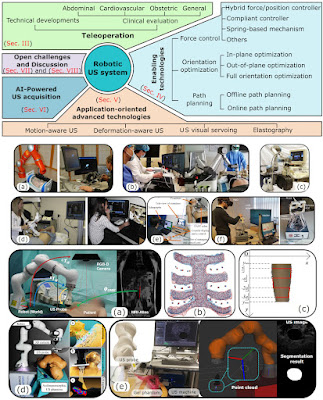Article intro -
A truly comprehensive survey paper appeared from Zhongliang Jiang, Septimiu E. Salcudean, Nassir Navab: "Robotic ultrasound imaging: State-of-the-art and future perspectives in Medical Image Analysis.
Abstract
Ultrasound (US) is one of the most widely used modalities for clinical intervention and diagnosis due to the merits of providing non-invasive, radiation-free, and real-time images. However, free-hand US examinations are highly operator-dependent. Robotic US System (RUSS) aims at overcoming this shortcoming by offering reproducibility, while also aiming at improving dexterity, and intelligent anatomy and disease-aware imaging. In addition to enhancing diagnostic outcomes, RUSS also holds the potential to provide medical interventions for populations suffering from the shortage of experienced sonographers. In this paper, we categorize RUSS as teleoperated or autonomous. Regarding teleoperated RUSS, we summarize their technical developments, and clinical evaluations, respectively. This survey then focuses on the review of recent work on autonomous robotic US imaging. We demonstrate that machine learning and artificial intelligence present the key techniques, which enable intelligent patient and process-specific, motion and deformation-aware robotic image acquisition. We also show that the research on artificial intelligence for autonomous RUSS has directed the research community toward understanding and modeling expert sonographers’ semantic reasoning and action. Here, we call this process, the recovery of the “language of sonography”. This side result of research on autonomous robotic US acquisitions could be considered as valuable and essential as the progress made in the robotic US examination itself. This article will provide both engineers and clinicians with a comprehensive understanding of RUSS by surveying underlying techniques. Additionally, we present the challenges that the scientific community needs to face in the coming years in order to achieve its ultimate goal of developing intelligent robotic sonographer colleagues. These colleagues are expected to be capable of collaborating with human sonographers in dynamic environments to enhance both diagnostic and intraoperative imaging.
Highlights
- Robotic ultrasound imaging: state-of-the-art and future perspectives.
- Enabling technologies of robotic ultrasound: force control, orientation optimization, and path planning.
- Learning-based robotic ultrasound imaging system.
- Motion-aware, deformation-aware, US visual servoing and elastography in robotic ultrasound.
Source: Elsevier



Comments